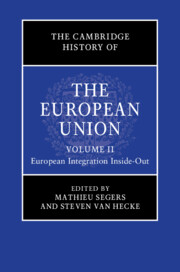Book contents
- The Cambridge History of the European Union
- The Cambridge History of the European Union
- The Cambridge History of the European Union
- Copyright page
- Contents
- Figures
- Tables
- Contributors to Volume II
- Acknowledgements
- Abbreviations
- Reflections on the History and Historiography of European Integration
- Part I Milestones: Treaties and Treaty Changes
- Part II Instruments of Integration
- Money and Society
- Challenges of Expansion: Protection and Security
- 12 The Institutional and Legal Culture of European Integration
- 13 The Formation of the Migration Regime of the EU
- 14 The Constitutional Dimension: Centralisation, Democratisation and the Rule of Law
- 15 EU Enlargement: Origins and Practice
- Part III Narratives and Outcomes
- Index
- References
14 - The Constitutional Dimension: Centralisation, Democratisation and the Rule of Law
from Challenges of Expansion: Protection and Security
Published online by Cambridge University Press: 12 October 2023
- The Cambridge History of the European Union
- The Cambridge History of the European Union
- The Cambridge History of the European Union
- Copyright page
- Contents
- Figures
- Tables
- Contributors to Volume II
- Acknowledgements
- Abbreviations
- Reflections on the History and Historiography of European Integration
- Part I Milestones: Treaties and Treaty Changes
- Part II Instruments of Integration
- Money and Society
- Challenges of Expansion: Protection and Security
- 12 The Institutional and Legal Culture of European Integration
- 13 The Formation of the Migration Regime of the EU
- 14 The Constitutional Dimension: Centralisation, Democratisation and the Rule of Law
- 15 EU Enlargement: Origins and Practice
- Part III Narratives and Outcomes
- Index
- References
Summary
The constitutional dimension of the European Union (EU) has to account for the fact that the Treaty Establishing a Constitution for Europe (TECE) seems to have failed in 2005 in the Dutch and French referenda. Thus we are unlikely to have a legal document officially called a ‘constitution’ in the foreseeable future. Yet, the designation is not decisive on its own (cf. the German Grundgesetz or the Hungarian Basic Law). Treaties can also be constitutions, as the examples of Cyprus (1960, Treaty of Establishment),1 the Constitution of Württemberg (1819), the Constitution of Saxony (1831)2 and the Norddeutsche Bund (1867) show.
- Type
- Chapter
- Information
- The Cambridge History of the European Union , pp. 385 - 410Publisher: Cambridge University PressPrint publication year: 2023



